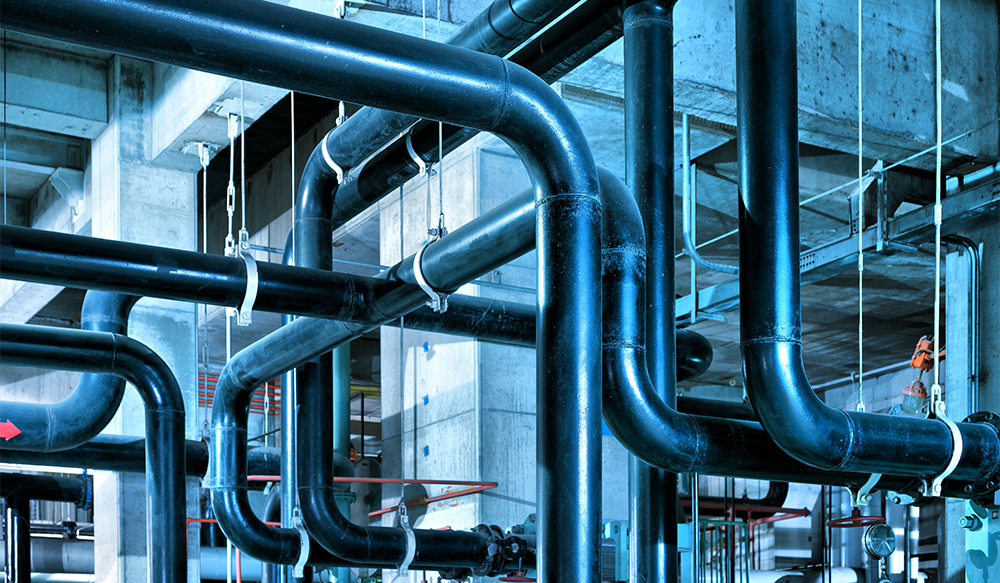
When it comes to choosing and installing pipe supports, there may be more at stake than you realize. A mishap could mean project interruptions, on-site damages, injuries, and long-term losses. In fact, the oil and gas industry was hit by more than $4 billion in damages over the last decade.
Luckily, a little free advice can keep you from massive costs down the road. We’ve learned from the most common mistakes out there. Here’s the best advice to keep in mind as you pick out and install pipe supports for your system.
1. Take care when you’re spacing out pipe supports.
Using improper spacing between pipe supports is one of the most common mistakes you can make during pipe support installation. What’s the big deal about spacing? If you’re supporting pipes with hangers or from overhead beams, the space between supports could determine how well your pipes hold up.
For instance, if your pipe supports are too far apart, it causes pipes to sag or flex. This creates several problems. First, little dips in the flow of pipe fluids act as detours for energy. Every time the flow of your pipe liquids is interrupted, it requires more effort and energy from your pump.
At the same time, saggy pipes are especially vulnerable to wear and can rupture. Or, fluids can easily pool in saggy spots, which can lead to crevice corrosion.
To get the most out of your system, set up spacing based on the weight of your pipes. If you notice drooping pipes, there’s a good chance that your pipe supports are too far apart.
2. Always account for pipe temperature.
When systems are shut off and you’re installing pipe supports, it’s easy to forget how hot or cold your pipes will get when they’re fired up and running. But temperature should always be on your mind as you’re picking out or installing supports.
If you have an extremely cold system, like a liquid natural gas (LNG) or cryogenic system, uninsulated supports can encourage ice formation. At the same time, systems that run hot require supports that won’t fracture in high temperatures. Before picking out pipe supports, do your research and make sure your support is up to the task.
And the same goes for support installation. As heat increases, piping materials flex. This means that you may need to include supports more frequently in hotter systems to stop pipes from sagging or flexing too much.
3. Match up your project’s materials.
Pipe supports are supposed to lengthen the lifespan of your system and fend off corrosion whenever possible. Unfortunately, pairing up dissimilar metals can actually encourage corrosion.
As you’re shopping for pipe supports, pay close attention to materials and finishes. Liners or insulation can work as a protective buffer between the metals of pipes and supports. Protective coatings like galvanizing or hot-dipped finishes can keep the wrong metals from connecting and doing damage.
Overall, make sure you understand the dangers of galvanic corrosion as you pick out supports. Even if more advanced products cost a bit more up front, they can save you money and headaches in the long run.
4. Remember your pipe’s working weight.
Of course, your pipe supports should be able to withstand the weight of your pipes. But forgetting to account for the weight of full, working pipes is a common mistake.
What’s more, the liquid your pipes transport can have a heavy impact on overall weight. Denser materials like chemicals put more weight on pipes than substances like water.
Essentially, the heavier your pipes are when they’re full, the more frequently you’ll want to use supports. This should keep your supports from buckling under the pressure and wrecking your operation.
5. Choose supports that fit your environment.
It’s extremely easy to overlook the environment your pipe supports will be exposed to every day. After all, some of the hardest elements to see are also the most destructive.
For instance, ocean air that’s salty and humid corrodes metal 10 times faster than air with normal salt levels. And the same goes for systems with high chemical exposure or those facing extreme temperatures.
Luckily, you reduce damage by paying attention to pipe support features that fit your system’s environment. Keep chemical resistance, waterproofing, material grade, and temperature tolerance in mind as you’re shopping for pipe supports. By doing a little extra research during the selection process, you’ll keep those less visible forces from wearing down your supports.
Want more pipe support advice?
We cringe when we see avoidable piping mistakes costing people money. And we’re here to stop disasters before they happen.
Have questions about your next project? Contact us today. Our pros will answer them, or get you a fast quote.






